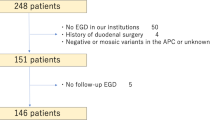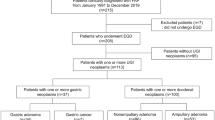Abstract
Advanced duodenal adenomatosis in patients with familial adenomatous polyposis (FAP) is associated with a significant risk of duodenal carcinoma. Duodenectomy is sometimes indicated to prevent malignant transformation or to resect established carcinomas. Advanced recurrent adenomatosis and cancer formation in the neo-duodenum after duodenectomy in FAP have been reported. The aim of this study was to describe findings during endoscopic follow-up in a cohort of FAP patients after duodenectomy, to assess the indication and whether recommendations can be made for endoscopic surveillance. All FAP patients with a history of duodenectomy performed at a single tertiary referral centre between January 2000 and July 2011 were identified. Patient characteristics and postoperative upper endoscopic procedures were reviewed retrospectively. 19 patients, with a mean age of 49 years at the time of duodenectomy were identified. One patient was lost to follow-up. The majority of patients underwent prophylactic pancreas preserving duodenectomy (95 %). Mean duration of postoperative follow-up in 18 patients was 78 months with 4 postoperative endoscopies on average. An increase in neo-Spigelman stage was seen in 9 patients, after an average interval of 35 months. Overall, newly formed adenomas in the neo-duodenum were found in 14 of 18 patients (78 %), after a mean of 46 months after duodenectomy. Recurrent adenomas were mostly located in close proximity to the neo-papilla. This included advanced adenomas in 7 patients, warranting enteric re-resection in 2 patients. Continued intensive endoscopic surveillance is indicated after duodenectomy in FAP, especially of the area around the bilio- and pancreatico-enteric anastomoses.

Similar content being viewed by others
References
Ruo L, Coit DG, Brennan MF et al (2002) Long-term follow-up of patients with familial adenomatous polyposis undergoing pancreaticoduodenal surgery. J Gastrointest Surg 6(5):671–675
Björk J, Akerbrant H, Iselius L et al (2001) Periampullary adenomas and adenocarcinomas in familial adenomatous polyposis: cumulative risks and APC gene mutations. Gastroenterology 121(5):1127–1135
Iaquinto G, Fornasarig M, Quaia M et al (2008) Capsule endoscopy is useful and safe for small-bowel surveillance in familial adenomatous polyposis. Gastrointest Endosc 67(1):61–67
Langers AM, De Vos tot Nederveen Cappel WH, Veenendaal RA et al (2008) Double balloon endoscopy for detection of small-bowel adenomas in familial adenomatous polyposis after pancreaticoduodenectomy according to Whipple. Endoscopy 40(9):773–774
Latchford AR, Neale KF, Spigelman AD et al (2009) Features of duodenal cancer in patients with familial adenomatous polyposis. Clin Gastroenterol Hepatol 7(6):659–663
Monkemuller K, Fry LC, Ebert M et al (2007) Feasibility of double-balloon enteroscopy-assisted chromoendoscopy of the small bowel in patients with familial adenomatous polyposis. Endoscopy 39(1):52–57
Bülow S, Björk J, Christensen IJ et al (2004) Duodenal adenomatosis in familial adenomatous polyposis. Gut 53(3):381–386
Bülow S, Christensen IJ, Højen H et al (2011) Duodenal surveillance improves the prognosis after duodenal cancer in familial adenomatous polyposis. Colorectal Dis 14(8):947–952
Groves CJ, Saunders BP, Spigelman AD et al (2002) Duodenal cancer in patients with familial adenomatous polyposis (FAP): results of a 10 year prospective study. Gut 50(5):636–641
Schulmann K, Hollerbach S, Kraus K et al (2005) Feasibility and diagnostic utility of video capsule endoscopy for the detection of small bowel polyps in patients with hereditary polyposis syndromes. Am J Gastroenterol 100(1):27–37
van Heumen BW, Nieuwenhuis MH, van Goor H et al (2012) Surgical management for advanced duodenal adenomatosis and duodenal cancer in Dutch patients with familial adenomatous polyposis: a nationwide retrospective cohort study. Surgery 151(5):681–690
de Vos tot Nederveen Cappel WH, Järvinen HJ et al (2003) Worldwide survey among polyposis registries of surgical management of severe duodenal adenomatosis in familial adenomatous polyposis. Br J Surg 90(6):705–710
de Castro SM, van Eijck CH, Rutten JP et al (2008) Pancreas-preserving total duodenectomy versus standard pancreatoduodenectomy for patients with familial adenomatous polyposis and polyps in the duodenum. Br J Surg 95(11):1380–1386
Gallagher MC, Shankar A, Groves CJ et al (2004) Pylorus-preserving pancreaticoduodenectomy for advanced duodenal disease in familial adenomatous polyposis. Br J Surg 91(9):1157–1164
Caillié F, Paye F, Desaint B et al (2012) Severe duodenal involvement in familial adenomatous polyposis treated by pylorus-preserving Pancreaticoduodenectomy. Ann Surg Oncol 19(9):2924–2931
Skipworth JR, Morkane C, Raptis DA et al (2011) Pancreaticoduodenectomy for advanced duodenal and ampullary adenomatosis in familial adenomatous polyposis. HPB (Oxford) 13(5):342–349
Lepistö A, Kiviluoto T, Halttunen J et al (2009) Surveillance and treatment of duodenal adenomatosis in familial adenomatous polyposis. Endoscopy 41(6):504–509
Mackey R, Walsh RM, Chung R et al (2005) Pancreas-sparing duodenectomy is effective management for familial adenomatous polyposis. J Gastrointest Surg 9(8):1088–1093
Sarmiento JM, Thompson GB, Nagorney DM et al (2002) Pancreas-sparing duodenectomy for duodenal polyposis. Arch Surg 137(5):557–562
Penninga L, Svendsen LB (2011) Pancreas-preserving total duodenectomy: a 10-year experience. J Hepatobiliary Pancreat Sci 18(5):717–723
Kalady MF, Clary BM, Tyler DS et al (2002) Pancreas-preserving duodenectomy in the management of duodenal familial adenomatous polyposis. J Gastrointest Surg 6(1):82–87
Al-Sarireh B, Ghaneh P, Gardner-Thorpe J et al (2008) Complications and follow-up after pancreas-preserving total duodenectomy for duodenal polyps. Br J Surg 95(12):1506–1511
Alderlieste YA, Rauws EA, Mathus-Vliegen EM et al (2013) Prospective enteroscopic evaluation of jejunal polyposis in patients with familial adenomatous polyposis and advanced duodenal polyposis. Fam Cancer Published Online First 12(1):51–56
Spigelman AD, Granowska M, Phillips RK (1991) Duodeno-gastric reflux and gastric adenomas: a scintigraphic study in patients with familial adenomatous polyposis. J R Soc Med 84(8):476–478
Mabrut JY, Romagnoli R, Collard JM et al (2006) Familial adenomatous polyposis predisposes to pathologic exposure of the stomach to bilirubin. Surgery 40(5):818–823
Chomchai C, Bhadrachari N, Nigro ND (1974) The effect of bile on the induction of experimental intestinal tumors in rats. Dis Colon Rectum 17(3):310–312
Berkhout M, Roelofs HM, Friederich P et al (2007) Ursodeoxycholic acid intervention in patients with familial adenomatous polyposis: a pilot study. Transl Res 150(3):147–149
Tong JL, Ran ZH, Shen J et al (2008) Association between fecal bile acids and colorectal cancer: a meta-analysis of observational studies. Yonsei Med J 49(5):792–803
Benetatos N, Ammori MB, Ammori BJ (2011) Laparoscopic pancreas-preserving total duodenectomy for familial adenomatous polyposis. Surg Laparosc Endosc Percutan Tech 21(6):e332–e335
Vasen H, Möslein G, Alonso A et al (2008) Guidelines for the clinical management of familial adenomatous polyposis (FAP). Gut 57(5):704–713
Balmforth DC, Phillips RK, Clark SK (2012) Advanced duodenal disease in familial adenomatous polyposis: how frequently should patients be followed up after successful therapy? Fam Cancer 11(4):553–557
Acknowledgments
We are grateful for the help of Dr. S. M. de Castro in updating the list of candidate patients in the current study.
Conflict of interest
None.
Author information
Authors and Affiliations
Corresponding author
Rights and permissions
About this article
Cite this article
Alderlieste, Y.A., Bastiaansen, B.A., Mathus-Vliegen, E.M.H. et al. “High rate of recurrent adenomatosis during endoscopic surveillance after duodenectomy in patients with familial adenomatous polyposis”. Familial Cancer 12, 699–706 (2013). https://doi.org/10.1007/s10689-013-9648-5
Published:
Issue Date:
DOI: https://doi.org/10.1007/s10689-013-9648-5




